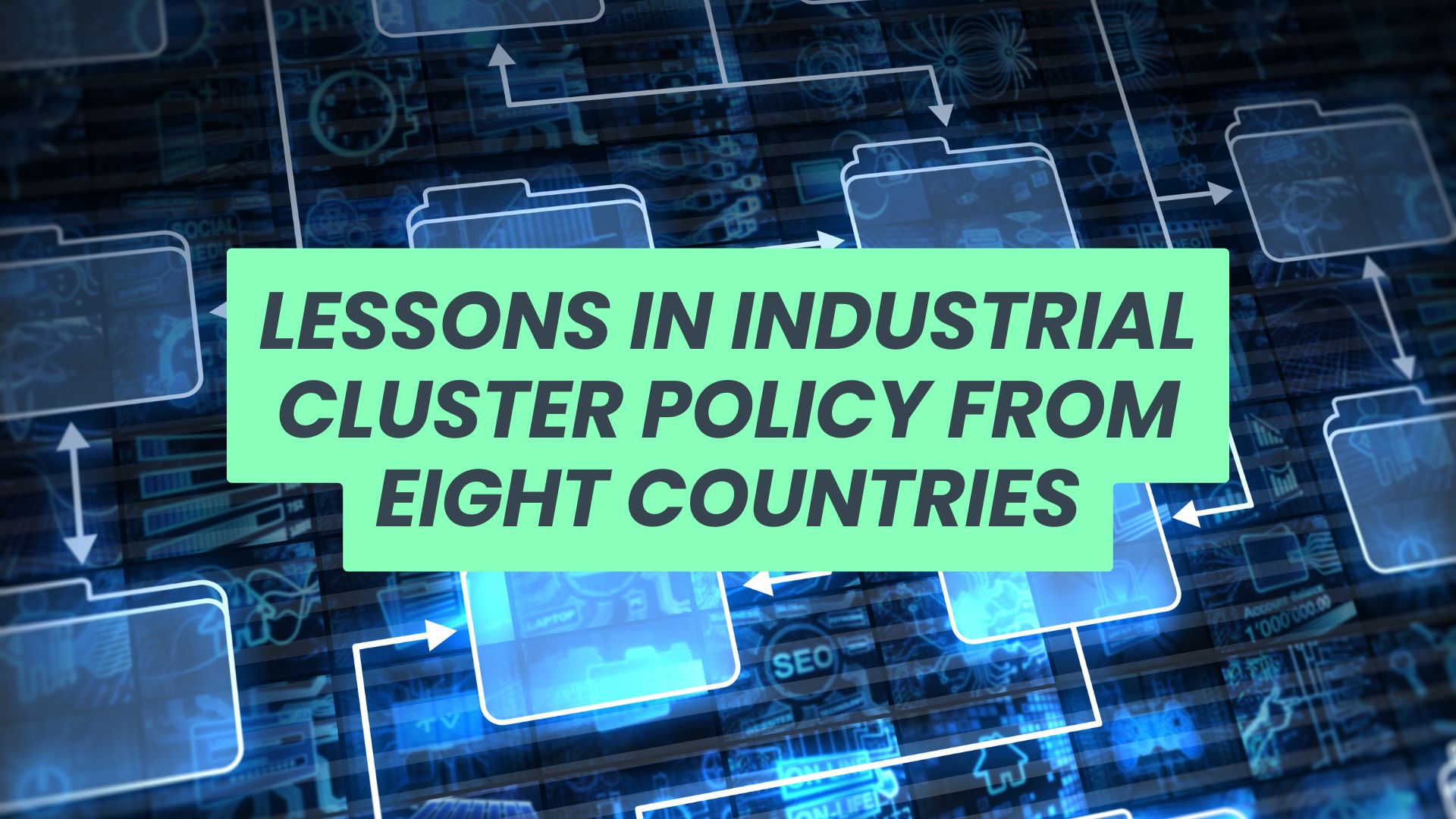I’ve been taking a deep dive on industry cluster development policies and delivery!
Here are the highlights of best practice for industrial cluster development, drawing from eight countries and regions…
Ireland:
- Clear, Consistent, and Long-Term Strategic Vision: Decades of consistent commitment to an open, export-led economy driven by FDI, with targeted sectoral focus.
- Highly Professional and Empowered State Agencies: IDA Ireland and Enterprise Ireland are world-class examples of well-resourced agencies providing comprehensive, client-centric support.
- Integrated Ecosystem Development: Strong collaboration between government, industry, and academia (Triple Helix model) to foster innovation and talent.
- Balancing FDI with Indigenous Growth: Increasing emphasis on deepening linkages between MNCs and indigenous suppliers, and scaling up Irish firms internationally.
- Regional Development Focus: Strategies explicitly aim to distribute benefits evenly across all regions.
- Responsiveness to Global Trends: Proactive adaptation to changes in tax regimes, geopolitics, and emerging technologies.
USA (highlighting North Carolina Research Triangle Park as a prime example):
- Leverage Existing Strengths & Bottom-Up Approach: Building upon a region’s existing competitive advantages, anchor institutions (universities), and established industry presence. Clusters are often grown organically.
- Strong “Triple Helix” Collaboration: Deep, symbiotic relationships between universities (research, talent), industry (innovation, jobs), and government (policy, funding, infrastructure).
- Investment in Talent and Workforce Development: Continuously aligning education and training programs with evolving skill demands of cluster industries.
- Enabling Ecosystem for Innovation & Entrepreneurship: Robust access to capital, incubators, accelerators, and environments that facilitate knowledge spillovers.
- Strategic Infrastructure Development: Targeted physical and digital infrastructure that directly supports the needs of the cluster.
- Patience and Long-Term Vision: Success takes decades of consistent effort and investment.
- Adaptability and Continuous Reinvention: Willingness to evolve the cluster’s physical and strategic focus to remain relevant (e.g., RTP 3.0).
- Quality of Place Matters: Creating desirable places where people want to live, work, and innovate attracts and retains talent.
Canada:
- Industry-Led and Business-Driven: Clusters are designed to be “business-led,” with the private sector identifying challenges and guiding strategic direction.
- Pan-Canadian Collaboration: Programs designed to foster collaboration across vast geographies, linking companies and researchers from coast to coast.
- Strong Emphasis on Intellectual Property (IP): A core tenet is supporting the creation, protection, and commercialisation of Canadian-owned IP.
- Targeted Focus on High-Growth Sectors: Concentrating resources on a limited number of high-potential sectors for deeper impact.
- Multi-Stakeholder Ecosystem Building: Fostering strong connections among industry, academia, government, and civil society (“Quadruple Helix” model).
- Focus on SME Growth and Scale-Up: Explicitly aiming to help small and medium-sized businesses scale up and integrate into global value chains.
Australia:
- Industry-Led Sectoral Strategies: Empowering industry to define its own strategic priorities and drive collaboration within its sector.
- Strong Skills-Industry Alignment: Recent reform to the VET system creating industry-led clusters for workforce planning and training design, ensuring the skills pipeline meets industry needs.
- Data-Driven Cluster Identification and Nurturing: Utilizing mapping and analysis to identify existing and emerging clusters for targeted interventions.
- Prioritizing Collaboration and Commercialisation: Programs that bridge divides between businesses and research institutions to facilitate knowledge transfer and commercialisation.
- Leveraging Regional Strengths and Transitioning Economies: Supporting clusters that help regions diversify, particularly those transitioning from traditional industries.
Denmark:
- Professionalisation and Centralized Support for Cluster Management: Well-funded, professional cluster organisations acting as neutral facilitators, with a national oversight body (Cluster Excellence Denmark) ensuring quality and strategic alignment.
- Long-Term, Consistent Policy Framework: Sustained commitment to cluster policy over many years, providing stability and predictability.
- Deep Integration of Knowledge Institutions: Actively pushing for seamless collaboration and knowledge transfer between companies and research, technology, and education environments.
- Internationalisation as a Core Element: Clusters are built with a global outlook, promoting cross-border collaboration and market access.
- Focus on SMEs and Scale-Up: Explicitly aiming to increase the competitiveness, productivity, and ability of SMEs to scale up.
France:
- Structured, Nationally Coordinated “Project Factory” Approach: Emphasis on directly funding concrete, collaborative R&D projects within clusters, with clusters acting as “project factories.”
- Strong Emphasis on Public-Private-Academic Partnerships: Mandatory collaboration for R&D projects fosters genuine interaction and knowledge transfer.
- Clear Evaluation and Adaptability: Regular performance reviews ensure accountability and allow for adjustments to the policy and the clusters themselves.
- Leveraging State Financial Tools Effectively: Dedicated inter-ministerial funds and public investment banks provide significant financial support.
- Integration with Broader Industrial Policy: Alignment of cluster policy with overarching national industrial strategies, such as green reindustrialisation.
Germany:
- Decentralized but Coordinated: Effective interplay between federal and state-level policies allows for both national strategic direction and tailored regional support.
- Robust Research Infrastructure: A strong network of applied and basic research institutes (Fraunhofer, Max Planck) with clear links to industry.
- Vocational Training Excellence: The “Dual System” ensures a highly skilled workforce that meets industry demands.
- “Hidden Champions” (Mittelstand): Policies that nurture and support a vast network of innovative, globally leading small and medium-sized enterprises.
United Kingdom:
- Clear Sectoral and Place-Based Prioritisation: Identification of key growth sectors and specific high-potential city regions/clusters for targeted support.
- Integrated Ecosystem Support: Recognition that a cluster includes not just businesses but also research institutions, skills providers, infrastructure, and informal networks.
- Bridging Research and Commercialisation (Catapult Model): World-leading technology and innovation centres that act as a bridge between academia and industry.
- Local Leadership and Cross-Boundary Working: Empowering local leaders and supporting collaboration across administrative boundaries.
- Long-Term Consistency and Funding Visibility: Acknowledging the need for consistent, long-term policy commitment to provide certainty for businesses and investors.
- Addressing Skills Gaps Directly: Tightly integrating industrial strategies with skills policy to ensure a pipeline of talent.
- Incentivizing Private Investment: Aiming to “crowd in” private investment through supportive policies.
- Net Zero as an Economic Opportunity: Proactively identifying and supporting clean energy industries and decarbonisation of industrial clusters.







